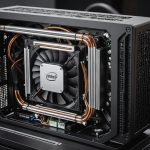Refurbished servers offer a smart alternative for businesses looking to enhance their IT capabilities without breaking the bank. They deliver reliable performance while being environmentally friendly. Understanding the various types of servers—like web, application, and database—can help you make informed decisions. This guide reveals the benefits and best practices for choosing quality refurbished servers that meet your organizational needs and empower your IT infrastructure.
Understanding Server Types and Functions
Servers are computers designed to provide services, data, and resources to other computers known as clients, within a network. They play an essential role in facilitating communication and data exchange across extensive networks, impacting both network performance and service delivery. A comprehensive overview of different server types reveals their significant contributions to computing environments.
Have you seen this : Unlocking Effortless and Secure File Sharing: A Comprehensive Guide to Utilizing Synology DS720+ with BTRFS
There are several types of servers, each fulfilling a specific role. File servers are crucial for storing and sharing files across the network, streamlining data access for users. Web servers, like Apache or Nginx, are responsible for handling user requests for web pages and services. These servers are fundamental for hosting information and facilitating online interactions.
Database servers, such as Oracle and Microsoft SQL Server, manage large volumes of data and accommodate simultaneous database requests, ensuring efficient data organization and retrieval. Meanwhile, application servers host applications, allowing centralized software management for multiple users, thereby improving efficiency and reducing redundant installations.
Also to discover : Ultimate Guide to Enhancing Airflow and Cooling in Compact SFF Cases for Intel Core i7-10700K
For those interested in exploring refurbished server solutions, the page https://eshop.evernex.com/ offers detailed options, including sustainable and reliable server upgrades, as well as compliance with international standards, ensuring quality and performance.
Choosing the Right Server for Your Needs
Hardware Specifications and Selection
When choosing a server, understanding the hardware specifications is essential. Servers typically boast multiple CPUs, increased memory capacity, and redundancy features to ensure optimal performance and reliability. This robust configuration is crucial for handling mission-critical workloads, which demand high availability and exceptional processing power. Evaluating the server hardware comparison can guide your decision, helping to match your workload demands with the right server capabilities.
Comparing Dedicated and Cloud Servers
A clear distinction in server choices arises between dedicated servers and cloud-based solutions. Dedicated servers, offering unique resources, are lauded for performance, control, and consistent operation, particularly suitable for enterprise applications. Conversely, cloud servers provide flexibility and scalability, reducing upfront infrastructure costs. When weighing cloud server vs on-premise options, consider factors like budget constraints, scalability needs, and resource control.
Licensing and Compliance for Server Use
Navigating the complexities of server licensing and compliance is critical for ensuring legal and practical use. Adhering to licensing requirements not only ensures compliance but also maximizes resource utilization. Familiarizing yourself with licensing structures and compliance guidelines can mitigate risks and support seamless server management, safeguarding against potential legal pitfalls. Understanding these aspects guarantees both efficiency and peace of mind.
Setting Up and Maintaining Your Server
Best Practices for Server Maintenance
Ensuring your server operates smoothly starts with adhering to server maintenance best practices. Regular updates to your server software and operating system are crucial as they incorporate security patches and performance improvements. Monitoring server logs can help identify potential hiccups before they turn into larger issues. Implementing proactive server security measures like multi-factor authentication, firewalls, and antivirus programs is essential to protect against threats.
Strategies for Virtualization and Efficiency
Integrating server virtualization techniques can optimize resources and reduce physical hardware needs. Using hypervisors, you can run multiple virtual machines on a single server, boosting efficiency and compression of physical space. Consider server load balancing to distribute traffic evenly across your network, enhancing stability and performance.
Backing Up and Troubleshooting Your Server
Reliable server backup solutions are indispensable for data integrity. Establish automated backup systems and routinely test them to ensure data recoverability in case of failures. When faced with issues, troubleshooting server issues starts with isolating the problem through diagnostic logs and system checks, ensuring quick resolution and minimal downtime.
Advanced Server Technologies and Trends
The Role of Cloud Storage in Server Management
Cloud storage solutions for servers have revolutionized data management, enhancing flexibility and scalability. By shifting from traditional on-premise setups to cloud-based options, organizations can optimize resource utilization and reduce infrastructure costs. Amazon cloud hosting stands out as a leader, allowing seamless integration of servers with robust data recovery features, critical for disaster recovery for servers. This approach ensures that crucial business operations endure unexpected disruptions.
Tools and Techniques for Monitoring Server Performance
Server monitoring tools are indispensable in maintaining efficient server operations. These tools offer detailed analytics, helping to identify potential bottlenecks and perform necessary performance tuning for servers. By implementing reliable server monitoring tools, IT administrators can preempt server failures and optimize system uptime, improving overall service reliability. Server clustering for reliability further enhances service continuity, ensuring minimal performance degradation even during high traffic loads.
Overview of Advanced Server Technologies like Clustering and Containerization
Clustering and containerization for servers represent cutting-edge trends in modern IT infrastructure. Clustering enables multiple servers to work cohesively, delivering heightened performance and redundancy. On the other hand, containerization for servers fosters resource efficiency, allowing multiple applications to run in isolated environments on a single host. These technologies collectively drive server roles in network efficiency and resilience, offering sustainable solutions in today’s evolving digital landscape.










